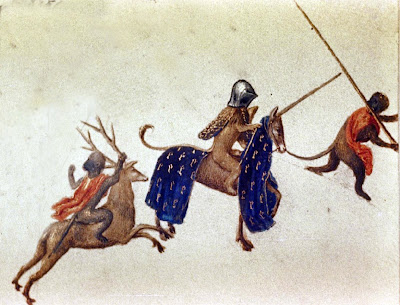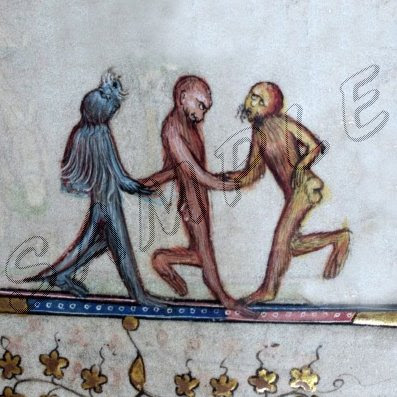I’ve been reading BoingBoing extra carefully this week, hoping that Cory would comment on his monkey doppleganger. Alas, nothing yet. But this extra attention means that I haven’t been able to just ignore the inane pseudo-academic ramblings of Douglas Rushkoff, BB’s current guest-blogger.
This in particular draws my ire:
For me, the development of a gamer from player to cheater to programmer mirrors our development as a society…. Before literacy, we were mere listeners. We heard stories read to us as a group. After the printing press, we were elevating to individuals, each with our own, acknowledged perspective on what we read. (The Renaissance, if anything, was a celebration of individual perspective – just like the paintings.) This reading phase took us right through the reading equivalent of cheating: postmodernism, cut-and-paste, and other personal deconstruction of the author’s original intent.
Finally, computers have changed our relationship to the text again. Instead of just reading the publications of others, we are free to write and distribute our own – on a relatively level playing field. We become authors.
I can’t say exactly if Rushkoff means to conjure up a pre-literate society, one that actually has little to no written language, or instead one like much of Europe during much of the Middle Ages, a society in which the general populace is illiterate and literacy is primarily the province of an “elite” subclass of specialists. I’ll assume it’s the second, since he describes these stories as being “read” rather than recited from memory.
Certainly, there was some group-reading-to going on in the Middle Ages. In fact, lots of the manuscript images that I show off here during my Mmm… Marginalia are from gigantic books designed to be displayed as they were read–the Bodeian Alexander manuscript with the drunken monkeys, and Yale’s Lancelot MS, are about the size of a (modest) TV when you open them up. Reading these manuscripts was a performative art, with the reader at the center. But the listeners, out on the periphery, are free to interpret and reinterpret the story they are receiving.
The textual margins, with their drunken monkeys and bizarre scatalogical humor, seem to be begging the audience to engage in just that sort of interpretive play. The reader might be reading aloud the story of Lancelot, but you, the audience, can see that on the same page as the main narrative, there’s a man getting shot in the ass out to the side, and it’s up to you to figure out how that’s relevant to the main story, or perhaps even to turn away from the story entirely and to just sit and think about how funny ass-shots are while that jerk who knows how to read just drones on and on about how awesome a knight Lancelot was.*
And this is just one sort of medieval textual activity. It’s hard to say exactly who the “we” in Rushkoff’s pre-literacy societies is supposed to be. Maybe he’d cry foul and say that these elaborately ornamented books were just for rich folk, the nobles with too much time on their hands. And he’d be right there. But I imagine that at least part of that “we,” is composed of the time-displaced analogues of the people who read BoingBoing now–folks with some spare time, some spare money, and an interest in technology. These sorts of people did not suddenly come into being in the Renaissance as a side-effect of the printing press.
Before the printing press, people had books–not as many books, surely, but they had books. And some of them loved books. They loved books the way BoingBoingers love Altoid tins and open source software projects. As hard as it is to believe, books were themselves once a cool, innovative technology, and that “once” happened well before Gutenberg came along.
Medieval book enthusiasts were DIYers. They made their own books. They copied texts they liked, freely editing and recomposing–or hacking, remixing, and cut-and-pasting, to use the right lingo. Take a certain fifteenth-century Englishman who went by the name “Rate,” for example. We know him, because he signs his name to a manuscript collection he put together, a book today held by the Bodleian Library that goes by the name MS Ashmole 61. It’s what specialists would call “a commonplace book,” and as other medieval scholars have pointed out, commonplace books had a lot in common with blogs. Scribes collected together texts they liked and copied them down into books for their personal use. If there was a romance floating around they liked, they would “rip” a copy of it into their commonplace book, alongside other things that caught their interest– including recipes, sermons, devotional stories, saint’s lives, dirty jokes (including fabliaux), registers of their finances, lists of animals that start with the letter A, the birthdays and christening days of their children, songs, and so on, and so on.
Rate’s commonplace book is pretty common in this regard. MS Ashmole 61 includes a lot of things I’ve already listed; it’s got some short exempla, a Breton lai or two, several romances, and some fabliaux. Rate was a pretty sentimental guy, apparently, so a lot of the texts in his commonplace book can be lumped together as “stories about faithful husbands and wives that end happily.” But a lot of the texts he writes down, he alters as he does, to make them fit his own tastes. He apparently didn’t have (or didn’t like) the beginning of Sir Orfeo, so instead he made a new one out of a few lines he did like from the completely unrelated poem Of Arthour and Merlin (which happen to mention happy couples). Rate also decided he didn’t like how the sinner of the Sinner’s Lament didn’t have a name, so he edits the first few stanzas to name him as “Sir William Basterdfeld of England” (pun intended) and then he took the whole Lament and turned it into a prologue for his copy of The Adulterous Falmouth Squire.
Rate is notorious, but hardly an anomaly. People were simply a lot savvier consumers of texts in the Middle Ages than they’re often given credit for. If they saw a miniature they liked in one book, they might go to their local bookshop and ask for a version to be pasted into one of their books. Or they might take their business to one shop over another because, “That scribe they have there does a mean Piers Plowman, and his Chaucer’s not bad, either.”** At least one manuscript of Wace, the French translator of Geoffrey of Monmouth’s History of the Kings of Britain, inserts all of Chretien de Troyes’ Arthurian romances into the middle of the history’s section on King Arthur–which would be kind of like pasting the script of the Untouchables into your 20th Century American History textbook right after the chapter on Al Capone or splicing up Shakespeare in Love to serve as a frame to your copy of Romeo and Juliet.
As I’ve argued here before, it’s absurd to think of the printing press as a sudden world-shattering technology. People were jazzed about the printing press because it allowed them to do on a larger scale things that they already were doing with written texts. It was an advance in scope, not in kind. In fact, if anything, the printing press was more like Windows to the text-hacker scene. Moveable type forces text to behave. It standardizes presentation, creating identical products. Every copy of Sir Orfeo produced by a press has exactly the same beginning, middle, and end. Marginal notes suddenly stick out as interlopers; they’re handwritten and shabby compared to the crisp machined text.
Rushkoff–and most of the people linked at BoingBoing–are committed to the American metaphor of technological progress. Important advances always start with an idea that nobody properly appreciates, an invention by an outsider (possibly with brightly colored hair or inappropriate piercings) that is initially scoffed at and even suppressed by a monolithic pig-headed status quo (of faceless disapproving men in grey business suits), and then, when it finally hits the market, this technological doodad revolutionizes everything, completely supplanting what came before. I think part of the reason why we medievalists have such a hard time convincing people that the Middle Ages was not a homogeneous thousand years of people coated in their own shit is the pervasiveness of this metaphor.
—
*In fact, this sort of play gets taken one step further, as characters within romances are themselves often depicted as writing and reading romances and images based on them. Arthur’s knights return to court to have their adventures dutifully recorded. Lancelot draws pictures of his love for Guenivere on the wall of his cell while imprisoned by Morgan le Fay, and then Arthur has to come along later and piece the story together then. The heroine of The Knight with Two Swords is given a mantle with the story of Arthur’s conception embroidered along one edge. Chretien has his Fenis tell her love Cliges that she will not play the part of Isolde to his Tristan. Really, I could keep listing ways that medieval writers play with intertextuality and reinterpretation all day.
**And speaking of Piers Plowman, its author, Langland, appears to have revised it every few years, at least once by using other people’s imperfect copies of Piers rather than his originals as the basis for new revisions.

















Recent Comments